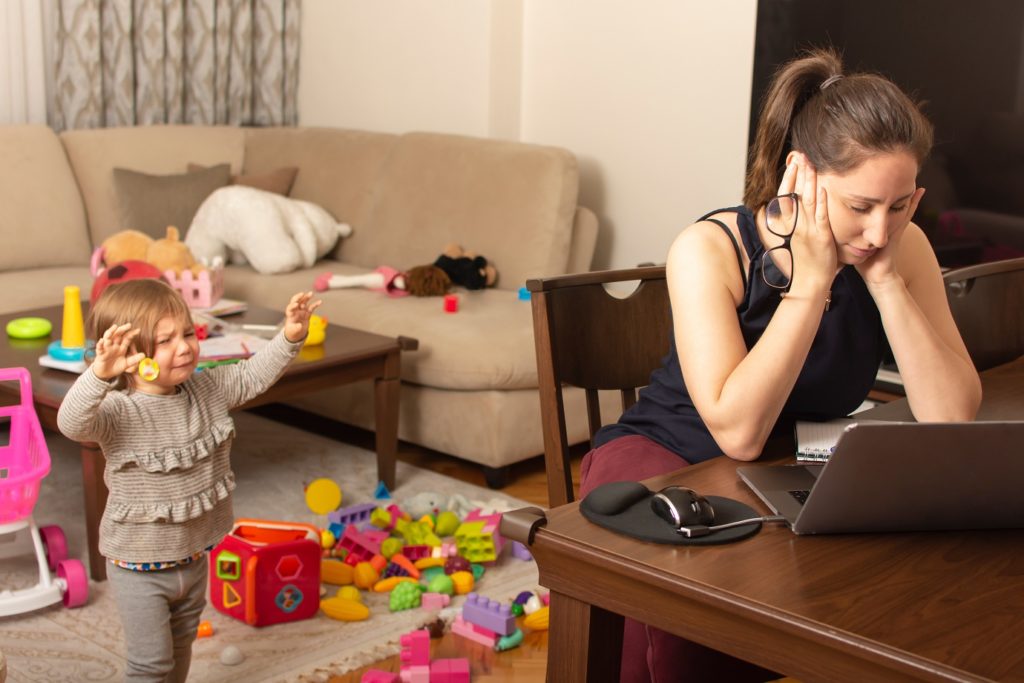Returning from maternity leave to her managerial role in the public service with a toddler was always going to be a challenge for Emma. But the newly created job-sharing position helped make the balance possible. She was also fortunate to have found good childcare for her daughter.
With the latest lockdown restrictions closing childcare to non-essential workers, Emma has been able to call on some limited support from busy grandparents, but it’s irregular and she’s worried about increasing their risk of catching the virus on top of everything else.
Now as she manages these competing demands from her work and her toddler, she’s nearing the end of her tether, very aware how unsustainable the situation is.
I am hearing stories exactly like Emma’s every day as lockdowns continue in Melbourne and Sydney. The pressure on working mums in particular keeps building with women carrying the majority of the increased physical, mental and emotional load of caring for children in lockdown.
The closure of childcare and schools again has been the final straw for many and they have made the unhappy decision to stop work completely or take personal leave to care for their children full-time.
The alternative is to just keep doing the exhausting and often demoralising home-learning/Zoom-working/domestic juggle as best they can.
I’m sure this feels very familiar to many women reading this.
The good news is that eventually as the vaccine coverage grows lockdowns will become less likely, but it is becoming sadly clear that the long-term impact will be felt in workplaces for years and it will be women who will be most disadvantaged.
A recent report by the Grattan Institute revealed Australian women have suffered a “triple whammy” of job insecurity during the COVID-19 pandemic which will compound women’s lifetime economic disadvantage.
Not only did women lose more work than men – almost 8 per cent at the peak of the crisis, compared to 4 per cent for men – but they took on more unpaid work and were less likely to receive government support.
Single parents, the majority of whom are women, have also struggled. While single mums employed in retail and hospitality were on the frontline of the early job shedding, the Grattan report says only 13 per cent of single mothers received the Jobkeeper subsidy. The research also notes that single parents were more likely than double-income couples to drop out of labour market participation during the crisis.
And let’s not forget about other carers. For those of us with ageing parents and other caring responsibilities, keeping our loved ones safe and well is a huge concern. That job almost always falls to women in a family.
Economists and workplace academics warn breaks in labour force participation could set women’s superannuation and long-term financial security back and further erode equality gains made over time.
It’s already happening.
In disturbing proof progress made on gender equality outcomes can quickly disappear, figures released this month by the Workplace Gender Equality Agency (WGEA) show Australia’s national gender pay gap has widened, up 0.8 percentage points to 14.2 per cent. That means women working full-time are now taking home $265.50 a week less than full-time men.
WGEA announced that “Equal Pay Day 2021” as August 31 this year, marking the 61 extra days women have to work from the end of the financial year to achieve the same annual pay as men.
So what can we do to stop this negative trend?
Returning to the office feels far away at the moment, but in coming months we expect to return, even if only part-time.
What is clear though is that hybrid working is here to stay for years to come so let’s not waste this opportunity. We need to learn the lessons from the past 18 months and make it work more fairly.
For a start, initial research has found that women are more likely than men to continue working from home when we can go back into the office. We know many men have appreciated the flexibility that working from home has provided when it comes to looking after kids, helping with homework, cooking and shopping. But we may also expect many such men may fear asking for more flexible hours once lockdowns end and more offices reopen.
It’s a reasonable fear: research has shown that men are much more likely than women to have requests for flexible work rejected and are also much more likely to be overtly stigmatised if they work flexibly. We can never achieve equality in our workplaces and an equal sharing of unpaid housework if managers continue to treat men and women differently.
The new hybrid working culture that is likely to emerge may offer some advantages in flexibility, but also brings new types of potential discrimination. The most obvious is working from home can easily result in a lack of visibility in the office. If the boss doesn’t bump into you around the office, you may not be front-of-mind for a plum project that could help your future career progression.
And for many, remote work has also created a culture of feeling the need to be “always on”, which also creates pressure with many describing struggling to switch off. They fear their career progression will be adversely impacted if they aren’t seen to be always available.
Emma is all too familiar with the constant tug of war between work meetings and fostering and participating in her child’s learning. She described a particular work meeting interrupted by her toddler who required urgent assistance in building a triceratops out of paper plates. She’s lucky she has colleagues who are either in the same position themselves or understand the difficult juggle that COVID has wrought on primary carers.
Understanding and caring bosses and colleagues will help get us through this current tough period, but until we address the structural and cultural drivers that work against women’s equality, including outright discrimination, unconscious bias and rigid gender role expectations, real progress will be slow.
Obligations under the new Victorian Gender Equality Act, which provides the authority for my role as that state’s first – and Australia’s first – Gender Equality Commissioner for the Public Sector will see 300+ organisations publicly accountable for making meaningful progress in addressing the systemic and cultural drivers of gender inequality. The Act requires transparent reporting, and it has real teeth – my role has the strongest powers to enforce compliance than any other equality legislation in the country.
These aspects combine to give us the strongest chance of addressing these gender equality gaps – and showing the rest of the country how it’s done.


